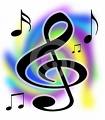Sounds International - Kampala, Uganda
Some abbreviated examples of the materials that our students are given...

Educational Handout for SIMS F/2 – Keyboard Literacy
1 4 5
So in C Major they are: C, F and G.
In G Major they are: G, C and D.
8. Minor Scales and Chords – The main difference between Majors and Minors is all about the 3rd note of the scale. In Minors it is flattened by a Semitone (one step). So C Minor root position chord is: C Eb G. In G minor is it: G Bb D
9. For every Major key there is a Relative Minor. How to find them is easy: from the Major just count down three Semitones (3 steps) then use fingers 1 3 5 and make sure the 3rd is flattened by one Semitone. The Major and Relative Minor are very closely associated which means you can substitute one for another, depending upon the mood and feel of the lyrics, without changing the Melody.
Educational Handout for SIMS F/3 – Drum Rudiments
Sell yourself in 30 seconds on stage! Imagine any job engagement in whatever field – practice making an appropriate and enthusiastic impression. Dress sense…
‘She’s got diamonds on the soles of her feet’ – Paul Simon
Uganda Performing Right Society (UPRS) – What is your copyright?
Expected learning outcomes:
How to hold the sticks – matched grip or cross-sticking
Drum stick ‘push-ups’ and double hand ‘roll-overs’
Names and how to play the drum kit instruments – Kick (bass drum), Snare (side drum), Hi Hat, (Rack) Toms 1,2,3, Crash and Ride Cymbals
Counting and the ‘Pulse’ – Quavers = 1+2+3+4+. Semiquavers = 1-ur-an-dah, 2-ur-an-dah, 3-ur-an-dah, 4-ur-an-dah. Triplets = 1-tri-plet, 2-tri-plet, 3-tri-plet, 4-tri-plet
Snare Drum rudiments
Accents ie. on the Hi Hat. >->->->- with Quavers. (Strong = > / weak = -)
Ride and Kick exercise
Rhythmic musical notation
Simple Rock and Ugandan rhythms
Sing at the same time!
Developing limb independence – Pat head + rub stomach then reverse...
Four crochets on the Ride Cymbal and quavers on the Kick Drum – 1+ rest rest +1
- Note names on a keyboard – Black Notes have two ‘spellings’ either as a flat (b) or a sharp (#) depending upon which key you are playing in.
- Keyboard fingering – Thumbs are 1 on both RH and LH. Therefore the little fingers (pinkies) are number 5.
- ‘Table Top’ finger exercises:
- LH – 5 3 2 4 3 1 2 4 (repeat in reverse)
- RH – 1 2 3 1 2 3 4 5 (repeat in reverse)
- Reminder from F/1 – The Diatonic Major Scale consists of Semitones (one step) and Tones (two steps) in this order: TTSTTTS starting on any note on the keyboard.
- C Major Scale – the fingering is as follows (also in the keys of D,E, G, A and B):
- RH – 1 2 3 1 2 3 4 5 – Ascending the thumb goes under. Descending the 3rd goes over.
- LH – 5 4 3 2 1 3 2 1 – Ascending the 3rd finger goes over. Descending the thumb goes under.
- Arpeggios are like Scales but only use notes 1, 3 and 5. This is the fingering for two Octaves:
- LH – 1 2 4 1 2 4 1 – Going Up ( In C major the notes are: C E G C E G C)
- RH – 1 2 3 1 2 3 5 – Going Up
- Technically in every key, and there are 12 Majors and 12 Minors, there are Eight chords. The strongest and most typically used are (the Three Chord ‘Trick’):
1 4 5
So in C Major they are: C, F and G.
In G Major they are: G, C and D.
8. Minor Scales and Chords – The main difference between Majors and Minors is all about the 3rd note of the scale. In Minors it is flattened by a Semitone (one step). So C Minor root position chord is: C Eb G. In G minor is it: G Bb D
9. For every Major key there is a Relative Minor. How to find them is easy: from the Major just count down three Semitones (3 steps) then use fingers 1 3 5 and make sure the 3rd is flattened by one Semitone. The Major and Relative Minor are very closely associated which means you can substitute one for another, depending upon the mood and feel of the lyrics, without changing the Melody.
Educational Handout for SIMS F/3 – Drum Rudiments
Sell yourself in 30 seconds on stage! Imagine any job engagement in whatever field – practice making an appropriate and enthusiastic impression. Dress sense…
‘She’s got diamonds on the soles of her feet’ – Paul Simon
Uganda Performing Right Society (UPRS) – What is your copyright?
Expected learning outcomes:
How to hold the sticks – matched grip or cross-sticking
Drum stick ‘push-ups’ and double hand ‘roll-overs’
Names and how to play the drum kit instruments – Kick (bass drum), Snare (side drum), Hi Hat, (Rack) Toms 1,2,3, Crash and Ride Cymbals
Counting and the ‘Pulse’ – Quavers = 1+2+3+4+. Semiquavers = 1-ur-an-dah, 2-ur-an-dah, 3-ur-an-dah, 4-ur-an-dah. Triplets = 1-tri-plet, 2-tri-plet, 3-tri-plet, 4-tri-plet
Snare Drum rudiments
Accents ie. on the Hi Hat. >->->->- with Quavers. (Strong = > / weak = -)
Ride and Kick exercise
Rhythmic musical notation
Simple Rock and Ugandan rhythms
Sing at the same time!
Developing limb independence – Pat head + rub stomach then reverse...
Four crochets on the Ride Cymbal and quavers on the Kick Drum – 1+ rest rest +1
